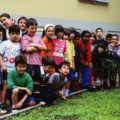Education through university level is basically free in Italy, at least in theory. You don’t pay tuition at most schools, but there are costs, including buying textbooks every year. There is something of a used-textbook market (in the Milan area, dominated by a chain of bookstores called Il Libraccio), but the publishing companies dilute its effects by frequent new editions. The teachers play into the system by insisting on the new edition, or changing the books entirely. I wonder if they get a kickback…?
The Ministry of Education has set theoretical limits for how much a family should be required to spend per child per year. According to a consumer group, this limit is 280 euros for 6th grade (the first year of middle school), 108 euros in the second year, and 124 euros in the third – the expense is front-loaded on the first year, as some books may be used throughout the three-year cycle of middle school. This consumer advocacy  group found that 34% of the families surveyed in Rome and Milan had spent more than the ministerial limit.
The limits are naturally higher in high school. Our daughter’s choice of liceo artistico (art high school) may be the most expensive option of all: besides a full quota of books for academic subjects, there are books for art history, and the ongoing expense of art supplies.
There are no lockers in Italian schools, so whatever books and supplies you need for class each day must be carried from home, in bulky backpacks. Years ago, parents began to complain that the number of books required each day was excessive, resulting in very heavy backpacks. Pediatricians pitched in with tales of childhood back pain and scoliosis, so a decree went forth from the Ministry of Education about the maximum weight a child could be made to carry (I think it was expressed as a percentage of body weight). How this was to be enforced was never specified; it would have required coordination among the teachers to decide who would require what books to be brought on any given day. I doubt that it was ever enforced. Backpacks with built-in wheels are popular, like that rolling carryon luggage that people use on planes, but, like the luggage, they are unstable, tending to flop sideways and twist your wrist, and the wheels only make them heavier when you have to tackle stairs. Backpacks are more comfortable to carry than old-fashioned leather satchels, but older adult commuters fondly remember the satchels – the habit was to drop them on the floor by your feet, whereas backpacks stay on backs and bash into everyone around them on the bus.
From what I remember of American public schools, books were lent by the school to each student every year. Presumably this was part of the school budget, and therefore covered by the parents’ taxes. American schools also have lockers to keep books in, though you then have the problem of forgetting at school a book you need for homework. When I was looking for a school for Ross in California, I found one that had resolved that problem by giving each student two full sets of books: one for school, one for home. Must have been expensive for the taxpayers, though.


